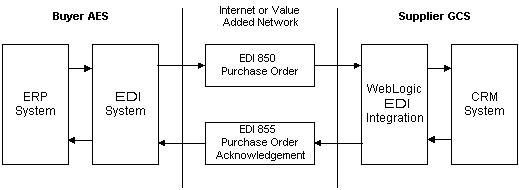

| Download Docs | Site Map | Glossary | |
|
|
|||
| bea.com | products | dev2dev | support | askBEA |
 |
 |
|
|||||||
| e-docs > WebLogic Platform > WebLogic Integration > B2B Topics > Using EDI > EDI Sample |
|
Using EDI
|
EDI Sample
This section describes the configuration and operation of the EDI sample. Because the EDI sample relies on the proper configuration of Power.Server!, you must configure Power.Server! before you can run the sample. (Such configuration is not a requirement for running the other samples provided with BEA WebLogic Integration.)
This section includes the following topics:
Sample Overview
The EDI sample contains a simple Purchase Order business process. Two trading partners are involved:
Advanced Networks buys control system components from General Controls. ANI uses EDI to send Purchase Orders to GCS and to receive Purchase Order Acknowledgments from Supplier GCS.
The Sample is based on the assumption that Supplier GCS uses BEA WebLogic Integration as its business-to-business integration solution, that is, as the framework in which it exchanges EDI documents with its trading partners. The architecture of WebLogic EDI Integration is shown in the following figure.
Figure 6-1 EDI Sample Scenario
The EDI sample is based on the assumption that Supplier GCS uses WebLogic Integration as its business-to-business integration solution for communicating with its trading partners using EDI. The architecture of the EDI sample is shown in Figure 6-2. Figure 6-2 EDI Sample Architecture
The sample consists of an inbound EDI 850 Purchase Order that is received by Power.Server! through an inbound file connection. The following summary describes the sequence of events in detail:
Setting Up and Running the Sample
This section lists the prerequisites for executing the BEA WebLogic Integration EDI sample and instructions for running it.
Prerequisites
Before you run the EDI sample, you must install all product components of BEA WebLogic Integration, including:
Note: Before you install the Power.Enterprise! software, make sure that your system meets the requirements and that you have any database access that is needed. For additional information about these prerequisites, see Installing BEA EDI Connect for WebLogic Integration.
Hardware and OS Requirements
Because the EDI sample is based on the assumption that you have access, on a single machine, to all of the software, including Power.Server!, Power.Manager!, and Power.Map!, the OS installation requirements are more restrictive than those for a production environment:
Configuring the EDI Sample
Configuration and execution of the EDI sample require you to perform the following steps:
The following files are available in SAMPLES_HOME\integration\samples\edi:
Note: Always start the Power.Server! before you start WebLogic Integration or WebLogic Server. The WebLogic Integration connectors expect Power.Server! to be running when they are initialized, and they throw exceptions if Power.Server! is not running when they are initialized.
Step 1: Start Power.Server!
Start Power.Server! by choosing Start Menu
Step 2: Start Power.Manager! and Configure Partners
Figure 6-4 Power.Manager! Add New Server Dialog Box
Figure 6-5 Power.Manager! Server Connection Dialog Box
Figure 6-7 Company Profiles List
Step 3: Start Power.Map! and Load Maps and Adapters
Figure 6-9 Power.Map! Main Window
SAMPLES_HOME\integration\samples\edi\EDI850toPOXML.jar
Figure 6-11 Promoting the Finished Map
SAMPLES_HOME\integration\samples\edi\POAckXMLtoEDI855.jar
SAMPLES_HOME\integration\samples\edi\XMLEnvelope.jar
Step 4: Set Up the Connections
Figure 6-12 List of Power.Manager! Connections
A dialog box for setting the inbound file properties is displayed
Figure 6-16 Inbound File Properties
Set the following properties:
A dialog box for setting the outbound file properties is displayed.
Figure 6-17 Outbound File Properties
Set the following properties:
Step 5: Set Up the Exchange Profiles
Step 6: Set Up the Workflow
Note: If you have executed the Run Samples setup, as discussed in "Preparing to Run the Samples" in "Getting Started" in Running the B2B Integration Samples, you can skip this step and proceed to Step 7: Deploy the Application View.
Figure 6-20 Importing the EDI Workflow
Step 7: Deploy the Application View
You have now finished configuring the EDI sample.
Step 8: Run the Sample
There are two ways to launch the sample:
power_enterprise_dir\powerit\powerapi\file_request -c
EDIFILE_2_POWERSERVER
Figure 6-21 Samples Launcher Page
You can monitor the sample during its execution from within Power.Manager!:
You can also monitor the sample from within the WebLogic Integration Studio:
To verify that the sample has run correctly, go to SAMPLES_HOME\integration\samples\edi. You should see a new file in the directory, which is autocreated by Power.Server! when the EDI message completes the cycle.

|

|

|